
Do you remember the 1970’s?
Sure, it was the era of questionable sartorial choices. Men wore very unnatural colors, showing up on dance floors as they tried to boogie until they couldn’t boogie no more.
In an energy sense, though, it was also the time of the dreaded mile-long gas lines.
Oil was in short supply at gasoline stations around the nation. It was an era of conflict. The nations that produced much of what the US consumed were none to happy with us and cut the nation off from their petrol spigots.
In those days, oil was a weapon. It was being utilized by the Organization of Petroleum Exporting Countries (OPEC) to punish the US for its support of the State of Israel as it was under attack by both Egypt and Syria.
This “oil war” spurred the US government into action. Rationing began, whereby certain markets had restrictions on gasoline sales to private and commercial vehicles. In addition, Congress passed, and President Richard Nixon signed, The Emergency Petroleum Allocation Act of 1973.
The act set into motion price controls on crude oil produced in the US – with existing known fields and reserves becoming price restricted, while new production was allowed to trade at market rates.
One of the interesting developments by Hess (HES) and Occidental Petroleum (OXY) was to use a newer technology of pumping CO-2 (Carbon Dioxide) into older oil fields that were no longer productive to release crude oil in rock formations. This would not only be considered “new” supplies of needed domestic oil – but those supplies would be able to trade at market rates. It was the semi-free market at work!
The projects were set aside by both companies due to challenges in the resulting crude oil. The trouble then was that the crude came up – but it was heavily mixed with water which made it prohibitive to use in what was then existing production and refining processes.
That Was Then – This is Now
Flash forward 40 years and crude oil production in the US is expanding. Over the last several years newer technologies have made it easier to release additional crude from oil fields – it’s the “shale boom” you’ve read about.
Conventional crude, as opposed to shale, is typically produced by drilling wells, pumping oil to the surface and then sending it onward to storage and processing facilities. This “conventional” process gets the easy oil but leaves a lot of crude still in the fields.
“Fracking” takes the additional step of using higher pressure water and chemicals to break up rock formations and forcing crude oil to the surface. The rock formations that they are breaking up is what’s called the “source rock.”
Over millions of years conventional oil leaked upward from this source rock. That’s what created pools of oil that sit under Texas and California. But today oil producers are heading lower for the source rock – and that requires new technology like fracking, where the source rock is fractured to release oil.
And while fracking has become one of the more exciting parts of the market for new oil – both tradition drilling and fracking still leave as much as 75 percent of the oil still in the ground.
Today we’re skipping the frack wagon.
1970’s Tech, 2013 Profit…
Injecting CO-2 into oil fields is what is referred to as Enhanced Oil Recovery or EOR. The process doesn’t break up shale rock – but rather acts as a sort of lubricant for crude oil to slip up and out rock formations which allows it to be pumped to the surface.
This process is quickly being adapted in the Permian Basin fields in Texas and New Mexico – but should be expanding nationwide in the coming months and years.
EOR is going to be big. Right now – fracking is producing around three million barrels per day (Mbpd) in the US – while EOR is seen to be ready to produce four Mbpd and many more to come.
The difference from the failed attempts in the 1970’s and now is that oil companies have new and increasingly common technology known as de-watering to not only make water-logged oil workable – but also makes the water available for other uses.
This EOR revolution will be adding a substantial amount of overall proven crude oil reserves in the US, which currently stand at around 222 billion barrels. EOR could increase that number to 323 billion barrels, or more – giving the U.S. the 5th largest crude reserves in the world.
Here’s the real twist: the capture and injection of CO-2 will even make the global warming folks happy! And if the future holds carbon permits for the U.S., perhaps companies utilizing CO-2 EOR can earn carbon credits.
Right now – CO-2 being utilized comes from the gas trapped in natural formations such as found in Saint Johns, Arizona. And the company piping the carbon is one of the picks I’ve shared with my readers – Kinder Morgan Energy Partners (KMP.)
Kinder Morgan is also expanding its pipe network for other sources of CO-2 including carbon captured by coal and natural gas power plants.
The other player in the EOR/CO2 field is a power company: The Southern Co. (SO.)
The company is working with big names like Siemens and Mitsubishi on not only capturing CO-2 but then storing it for sale to be transported by pipeline (likely a Kinder pipeline.) Southern would not only get carbon credits, but cash from oil companies purchasing the C0-2.
That’s the story: a lot more oil and less carbon dioxide in the air (the CO-2 can be recycled in the EOR process as well.) Plus, my favorite pipeline/storage companies will earn even more in the coming months and quarters, generating even more cash for higher dividends.
All my best,
Neil George
Daily Resource Hunter

























































